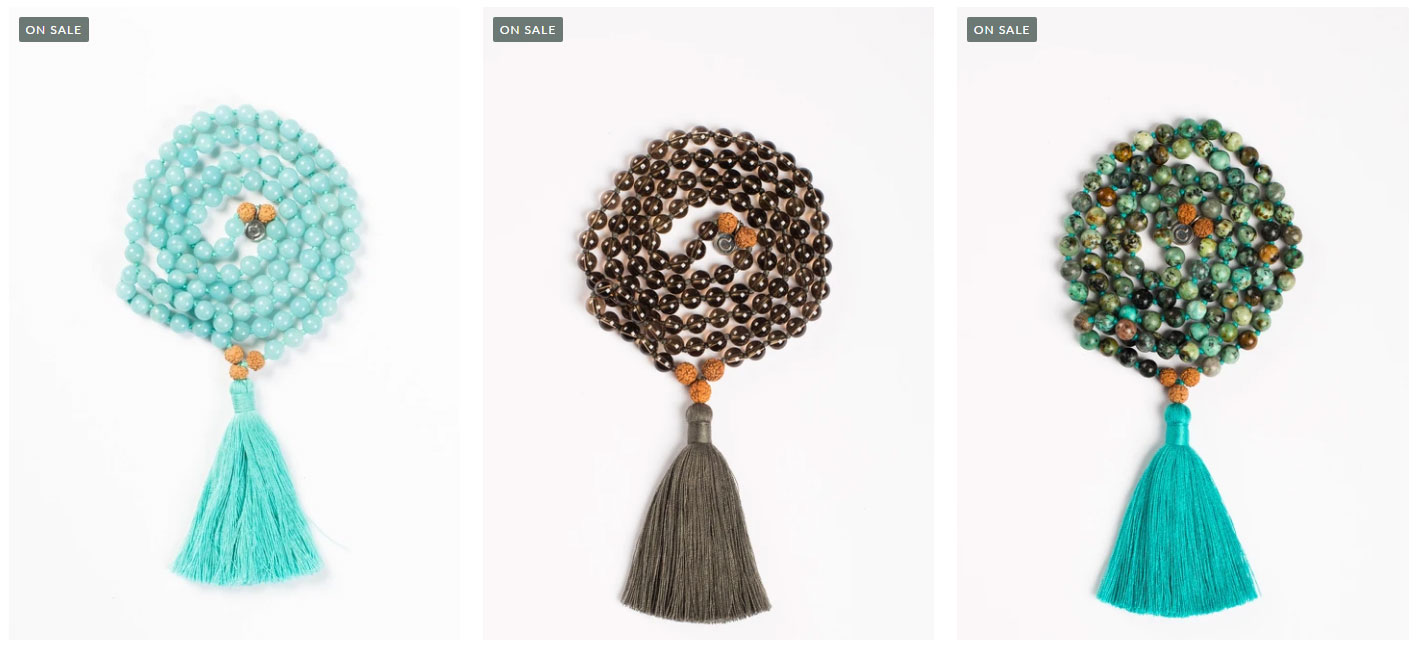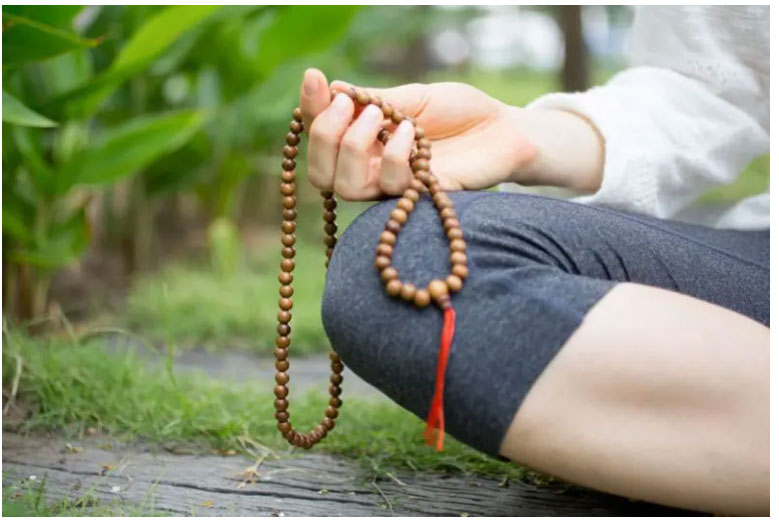Using Tibetan Malas
Tibetan malas are more and more present, worn as a bracelet or as a necklace. However, few people are aware of their original purpose. Indeed, these bracelets can be used to meditate, pray or practice yoga. You will discover in this article everything you need to know about these objects from Tibet, and you will then be able to look at the malas in a very different way than you would on a simple fashion accessory.
Discover the Tibetan malas
A mala is a kind of rosary. It can be worn as a bracelet (by winding it several times) or as a necklace. It is traditionally used to help those who pray or meditate. It is usually composed of 108 beads, you will understand why afterwards. It can be called in different ways that simply "Tibetan mala", such as for example :
• Tengwa (in Tibetan)
• Look-Pakam (in Thai)
• Buddhist bracelet
• Japa mala
Mala means "pearl garland", "flower necklace" or "meditation garland" in Sanskrit.
History of the malas
The history of these bracelets or necklaces goes back 3,000 years, when Buddhism, Hinduism, yoga and meditation were born. However, their exact origin remains a mystery: it is subject to the subjectivity of each person.
They were therefore initially used for a very particular type of meditation, the "Japa", which means "to recite". This explains why you may sometimes hear someone talking about "Japa mala".
The people of Tibet never gave jewelry a role of beauty: it could be used as an amulet, an aid to spiritual activities or an indicator of social status. Most jewelry was made from precious metals such as gold and silver. In addition to malas, they could also wear headdresses, with which women slept until the 1950s. Ivory rings were used by men to protect themselves from witches.
Until 1950, men and women of the ruling class had to wear ornaments adapted to special occasions: fines were even handed out if the wearing of ornaments was not well respected!
Today, the wearing of jewelry is mostly used on festive occasions, they are much less used in everyday life.
All these traditions explain the importance of malas in Tibetan culture.
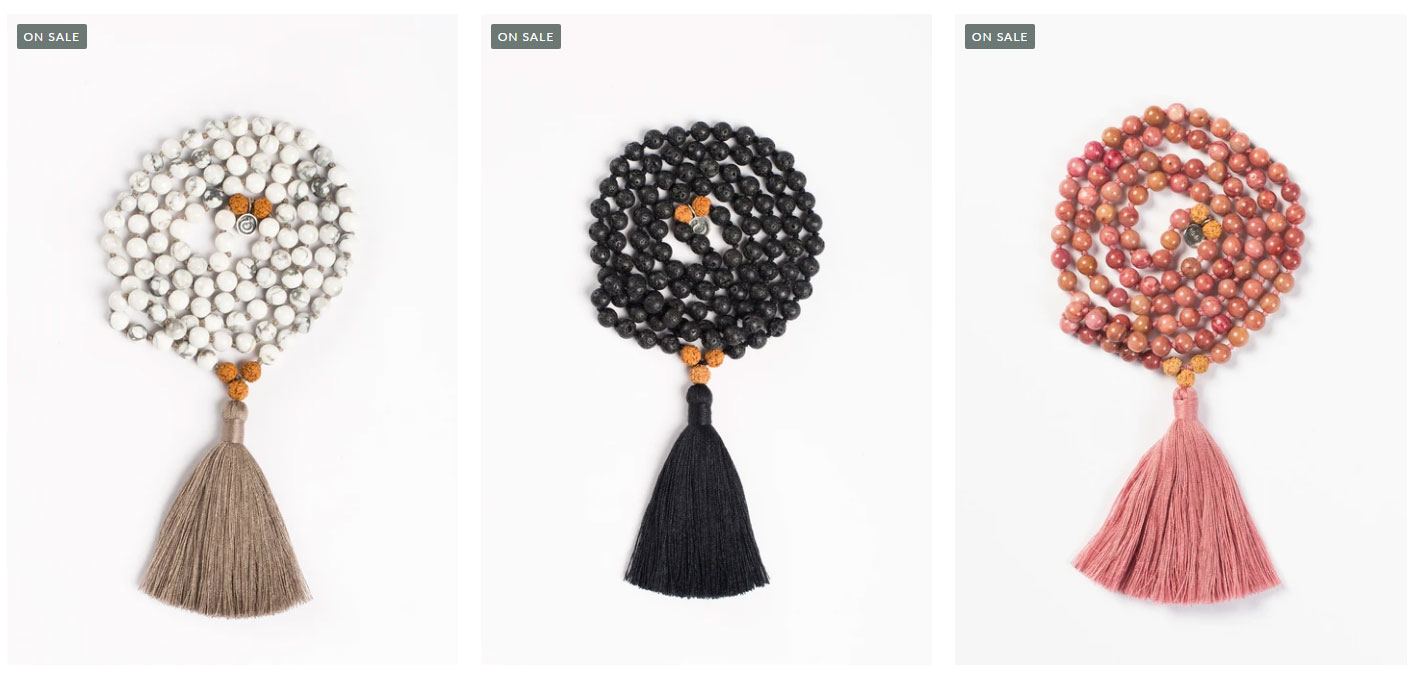
Understanding the traditional composition of a mala
A mala is, in the Tibetan tradition, composed of 5 parts. Each of these parts has a specific meaning:
• The largest pearl (called the head ball) symbolizes the knowledge of emptiness.
• The cone which is placed on this "head ball" is the representation of this same emptiness.
• A cord on which the pearls are threaded. It must theoretically be about a braid made up of 3 threads, symbols of the 3 bodies of Buddha which are the Body of emanation, the body of glory and the absolute body. It is also made up of 5 colored threads symbolizing the "five wisdoms" of Buddha and to finish, 9 threads symbolizing the Buddha as well as the 8 great Bodhisattvas.
• A counter finished by a Dorje representing compassion.
• A counter finished by a bell which symbolizes knowledge and emptiness.
However, this is only its theoretical structure, in practice there are many variations.
Why 108 beads?
A mala is a traditional tool used to count the number of recitations of a mantra, the number of breaths during a mediation, etc. They historically contain 108 beads. But why 108?
Here you will find different hypotheses explaining the number of beads a mala contains. The most important thing to know is that this number has a spiritual significance in many religious traditions. The reliability of the reasons presented varies enormously, and some explanations will certainly seem fanciful to you.
According to the regions and the interpretations specific to each one, the Buddhist rosary can thus include 108 pearls to represent :
• The 108 positions of yoga.
• The 108 movements of Tai Chi.
• The ratio between the diameter of the Sun and the diameter of the Earth which is about 108.
• The 108 tests which Buddha had to overcome to reach the enlightenment.
• The 108 tantric mudras (spiritual gestures).
• The angles of a pentagon which measure 108°.
• The 108 kleshas (spiritual sufferings) in Buddhism.
• The distance Earth-Sun which would be about 108 times the diameter of the Sun.
• The 108 names of Buddha.
• The 108 most sacred writings that Padma-Sambhava, the great Tibetan guru, is said to have hidden on the border with Nepal in northern Tibet after Buddha's death.
• The sacred Ganges River has a longitude of 12 degrees and a latitude of 9 degrees. Now, 9 x 12 = 108.
• The 108 gods and goddesses of the Hindu religion.
• The numbers 1, 0.8. In the Hindu religion, the 1 represents God, the 0 represents emptiness and humility, the 8 represents infinity.
• Time: the human would have 36 feelings related to the past, 36 to the present and 36 to the future which makes a total of 108.
• The lie: a person would be able to tell 108 major lies during his life.
• Sins: There would be 108 sins to avoid.
• Virtues: there would be 108 to cultivate.
• Meditation: Some say that there are 108 ways to meditate.
• The heart chakra: a chakra is a space of exchange between the body and the outside. In total, there are 108 lines of energy that go to the same point to form the heart chakra, which is a center of balance that connects the physical and the spiritual of a person. Read our full article here.
• The 108 fires during the ceremonies of the cult of the dead in Japan.
However, one of the most probable explanations for the origin of this mysterious number remains the sum of the 12 months of the year, the 24 arrangements of the solar calendar and the 72 divisions of the Chinese year. Indeed, 12 + 24 + 72 = 108. If you want to retain only one explanation of its origin, this one will largely do the trick! Keep in mind that its meaning can be different for everyone: do not try to impose your own interpretation, but rather to be interested in and try to understand that of others, in order to enrich your points of view.
There could be examples related to the number in the hundreds, some of which are far-fetched: anyone could if they wanted to invent some. As you will have understood, it is better not to try to quote them all...
Although the malas are generally composed of 108 pearls, we find today very short Buddhist bracelets, of about twenty pearls for example.
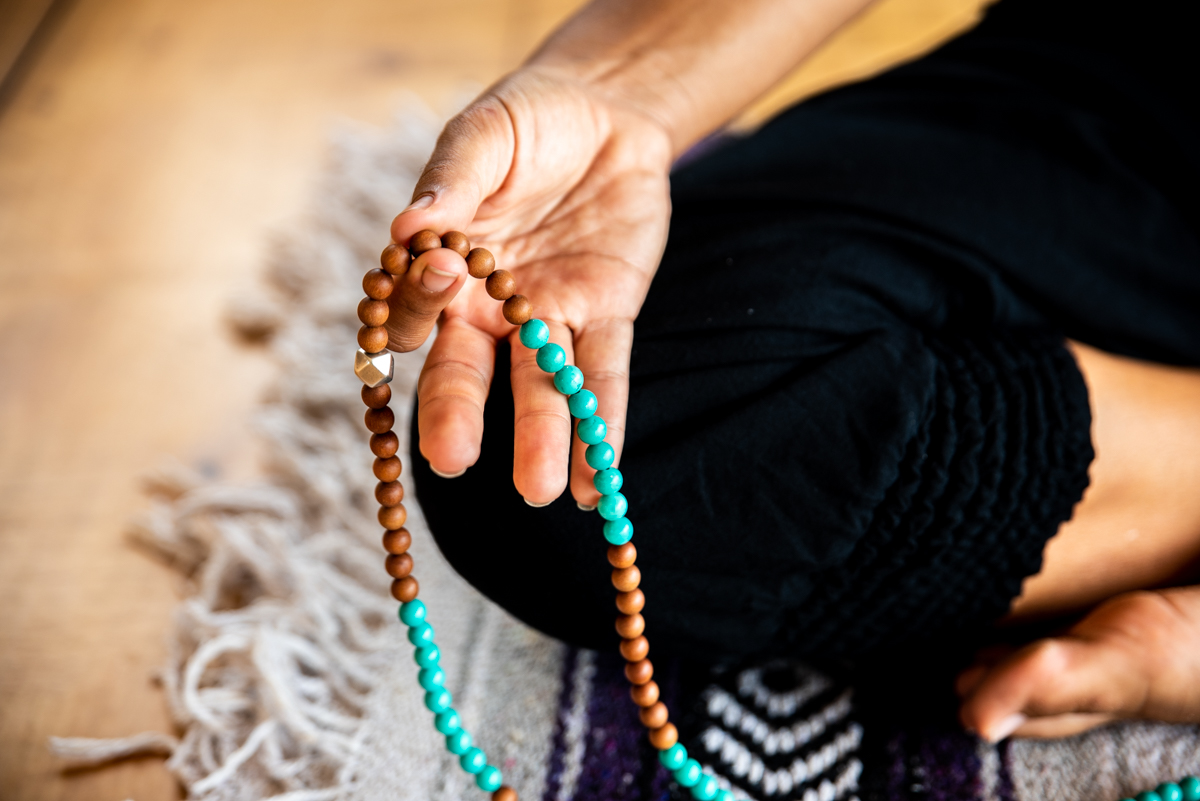
Using Tibetan bracelets
These bracelets can be used during yoga sessions, as a fixation point, in meditation, or during prayers. Here you will learn essentially how to use it for meditation.
They are held with the left hand in Buddhism and with the right hand in Hinduism, because the latter religion considers the left hand impure.
Here are some tips on how to use them well during your meditations:
• Place it in your left or right hand: don't get in your head!
• Pass a pearl from your Tibetan necklace over your thumb, at every religious recitation, every breath or mantra recitation.
• Sheathe the mala by pulling the beads towards you, so as to bring positive Karma towards you.
• Stay focused on the main goal of your practice, don't fall into the trap of reciting without sincerity just by worrying about the number of repetitions!
The tour of the mala will be completed when you reach the Meru, which is a pearl different from the others.
Exercise with a mala
To introduce you to their use, here is an exercise that you can do now, from your home, which will allow you to apply the advice you have just received:
First, find a comfortable place where you won't be disturbed. Then, take a meditative break, with your mala in your left hand. Close your eyes. Inhale through your nose and exhale through your mouth, concentrating on your breathing. At the end of each inhalation and exhalation, bring a bead towards you. If your mind wanders, don't feel guilty, just try to bring your attention back to your breathing. Start bringing the beads back to you when you are fully focused on your breathing again. If you're just starting out, it will be difficult at first, but remember: Practice makes perfect!
If you're already experienced, have plenty of time ahead of you, and enjoy challenges, you can definitely start over at the beginning of the mala whenever your attention is no longer focused on your breathing.
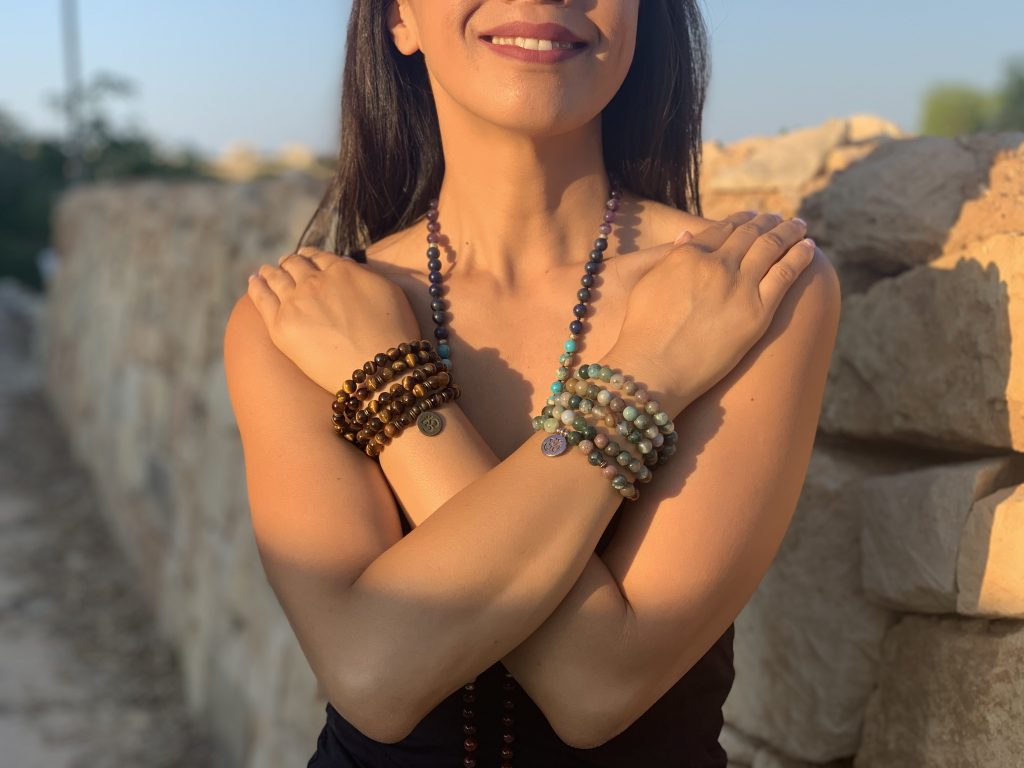
Other possible uses
In addition to spiritual use, malas can be used for fashion. They can be used as accessories, jewelry and give a totally different look to your style.
Finally, if you have no interest in fashion, religion, meditation or yoga, you can simply wear a mala to feel better. If you believe in it (again, not necessarily religious), a mala can allow you to purify yourself and repel negative waves. But what is certain is that no matter how you use it, you must use it in a way that fits your personality.
Choosing your mala
Different colors, different materials, and different lengths: you're bound to find one that suits your desires.
Choosing your Tibetan bracelet is a very personal act: your mala must inspire you, soothe you or simply please you, by its colors, its beads, the atmosphere it exudes, etc...
If you have a limited budget for your mala purchase, the price is obviously a criterion to take into account. You will find here our different mala necklaces.
Protect your bracelet from the effects of time
The maintenance of one's mala is a subject often neglected, but it is not less important. Different ways of doing it are possible, whether spiritually or more simply, materially.
Maintain it spiritually
A good way to do this is simply to wear it and use it as regularly as possible, during morning meditations for example. Wearing it often allows you to develop a spiritual attachment to your mala. This will allow you, each time you use it, to remember the sensations you have previously experienced: you will therefore reach them more easily.
Apart from using and wearing it often, here are some interesting methods to maintain it spiritually:
You can expose it to sunlight by placing it behind one of your windows or in your bay window. This can bring out its smell if it is made of wood, or make it smell better on your skin because of its warmth. Both of these factors can increase your connection with it by using your sense of smell and touch.
You can also expose it to incense smoke, which will be partly absorbed by your mala, which again, will allow you to better connect with it, through your sense of smell.
In a more esoteric context, the recitation of a mantra, a prayer, a chant will create a vibration that will purify your Tibetan necklace. Soothing music can also have a similar effect.
It is good to remember once again that a mala is a personal object, whose use and maintenance depends only on you!
Maintain it materially
When it comes to equipment maintenance, all you need is a little common sense. If you want it to stay in good condition for many years, just don't leave it outdoors in bad weather, don't drop it, etc.
To preserve it, it is best not to expose it to water, which could seep into the wooden beads of the mala and make them swell.
However, if you are an adventurous soul who doesn't want to worry about this: treat yourself! Whether you buy it from us or elsewhere, just keep in mind that you will have to buy some more if you take it everywhere with you, even in your shower.
Keeping the essentials
In short, a mala is :
● A bracelet or a necklace from Tibet
● An object originally used for spiritual purposes
● A structure full of symbols and a traditional composition of 108 beads
● Different possible uses: meditation, yoga, fashion, religion...
● Something personal, that must suit your taste
● Something that, like everything else, requires maintenance!
